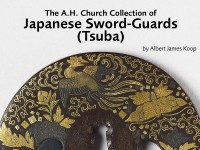The A. H. Church Collection of Japanese Sword-Guards (Tsuba)
An unpublished catalogue of the A. H. Church collection of Japanese sword-guards (tsuba) by Albert James Koop.

Publications online: 38 objects
Show search helpTsuba depicting the battle of Uji river
-
Literature notes
The Uji-gawa episode (Gempei Wars, 1184). On the front is the well-known design, with Kajiwara Kagesuye on the bank of the Uji, bow in teeth, tightening his horse's surcingle, while Sasaki Takatsuna rides across the stream with drawn sword trailing in the water (to cut through possible entanglements); above are mist-enshrouded hills and pine-trees. The design continues at the back with a view of the Uji bridge, partly destroyed. Kagesuye's face is encrusted in silver, and a few details are in silver wire nunome (hands, sword-blade, arrow-featherings); the edge is richly gilt. Signed in nunome gold wire: Yamashiro no jū ("resident of Yamashiro province") Fujiwara no Kiyonaga [Japanese text] with kakihan [Japanese text] [see EAX.10859].
This artist appears to be unrecorded, though several of his guards are known, notably with a striking design of folding screens (one such in the V. and A. M.) -
Details
- Associated place
- Date
- c. 1800
- Material and technique
- iron, inlaid with silver, and with silver wire and gold wire nunome-zōgan decoration
- Dimensions
- 7.4 x 7.1 cm (height x width)
- Material index
-
processed material › metal › iron,
- Technique index
- Object type index
-
arms/armour › koshirae › kodogu › tsuba
- No. of items
- 1
- Credit line
- Bequeathed by Sir Arthur H. Church, 1915.
- Accession no.
- EAX.10858
-
Further reading
Koop, Albert James, The A. H. Church Collection of Japanese Sword-Guards (Tsuba), 3 vols (Oxford, Ashmolean Museum, 1929), no. 858
Glossary (2)
nunome-zōgan, tsuba
-
nunome-zōgan
Decorative application of metal sheeting (generally of gold or silver) where the iron ground is first cross-hatched and the metal burnished on.
-
tsuba
Japanese sword guard.
Location
-
- currently in research collection
Objects are sometimes moved to a different location. Our object location data is usually updated on a monthly basis. Contact the Jameel Study Centre if you are planning to visit the museum to see a particular object on display, or would like to arrange an appointment to see an object in our reserve collections.
Publications online
-

The A. H. Church Collection of Japanese Sword-Guards (Tsuba)
The Uji-gawa episode (Gempei Wars, 1184). On the front is the well-known design, with Kajiwara Kagesuye on the bank of the Uji, bow in teeth, tightening his horse's surcingle, while Sasaki Takatsuna rides across the stream with drawn sword trailing in the water (to cut through possible entanglements); above are mist-enshrouded hills and pine-trees. The design continues at the back with a view of the Uji bridge, partly destroyed. Kagesuye's face is encrusted in silver, and a few details are in silver wire nunome (hands, sword-blade, arrow-featherings); the edge is richly gilt. Signed in nunome gold wire: Yamashiro no jū ("resident of Yamashiro province") Fujiwara no Kiyonaga [Japanese text] with kakihan [Japanese text] [see EAX.10859].
This artist appears to be unrecorded, though several of his guards are known, notably with a striking design of folding screens (one such in the V. and A. M.)
Notice
Object information may not accurately reflect the actual contents of the original publication, since our online objects contain current information held in our collections database. Click on 'buy this publication' to purchase printed versions of our online publications, where available, or contact the Jameel Study Centre to arrange access to books on our collections that are now out of print.
© 2013 University of Oxford - Ashmolean Museum

